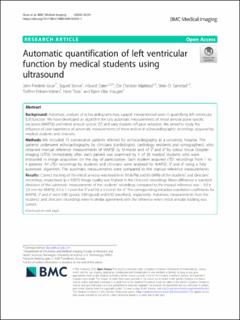| dc.contributor.author | Grue, Jahn Frederik | |
| dc.contributor.author | Storve, Sigurd | |
| dc.contributor.author | Dalen, Håvard | |
| dc.contributor.author | Mjølstad, Ole Christian | |
| dc.contributor.author | Samstad, Stein | |
| dc.contributor.author | Eriksen-Volnes, Torfinn | |
| dc.contributor.author | Torp, Hans | |
| dc.contributor.author | Haugen, Bjørn Olav | |
| dc.date.accessioned | 2021-04-30T09:28:13Z | |
| dc.date.available | 2021-04-30T09:28:13Z | |
| dc.date.created | 2020-05-28T14:51:44Z | |
| dc.date.issued | 2020 | |
| dc.identifier.citation | BMC Medical Imaging. 2020, 20 (1), 1-8. | en_US |
| dc.identifier.issn | 1471-2342 | |
| dc.identifier.uri | https://hdl.handle.net/11250/2740546 | |
| dc.description.abstract | Background
Automatic analyses of echocardiograms may support inexperienced users in quantifying left ventricular (LV) function. We have developed an algorithm for fully automatic measurements of mitral annular plane systolic excursion (MAPSE) and mitral annular systolic (S′) and early diastolic (e′) peak velocities. We aimed to study the influence of user experience of automatic measurements of these indices in echocardiographic recordings acquired by medical students and clinicians.
Methods
We included 75 consecutive patients referred for echocardiography at a university hospital. The patients underwent echocardiography by clinicians (cardiologists, cardiology residents and sonographers), who obtained manual reference measurements of MAPSE by M-mode and of S′ and e′ by colour tissue Doppler imaging (cTDI). Immediately after, each patient was examined by 1 of 39 medical students who were instructed in image acquisition on the day of participation. Each student acquired cTDI recordings from 1 to 4 patients. All cTDI recordings by students and clinicians were analysed for MAPSE, S′ and e′ using a fully automatic algorithm. The automatic measurements were compared to the manual reference measurements.
Results
Correct tracking of the mitral annulus was feasible in 50 (67%) and 63 (84%) of the students’ and clinicians’ recordings, respectively (p = 0.007). Image quality was highest in the clinicians’ recordings. Mean difference ± standard deviation of the automatic measurements of the students’ recordings compared to the manual reference was − 0.0 ± 2.0 mm for MAPSE, 0.3 ± 1.1 cm/s for S′ and 0.6 ± 1.4 cm/s for e′. The corresponding intraclass correlation coefficients for MAPSE, S′ and e′ were 0.85 (good), 0.89 (good) and 0.92 (excellent), respectively. Automatic measurements from the students’ and clinicians’ recordings were in similar agreement with the reference when mitral annular tracking was correct.
Conclusions
In case of correct tracking of the mitral annulus, the agreement with reference for the automatic measurements was overall good. Low image quality reduced feasibility. Adequate image acquisition is essential for automatic analyses of LV function indices, and thus, appropriate education of the operators is mandatory. Automatic measurements may help inexperienced users of ultrasound, but do not remove the need for dedicated education and training. | en_US |
| dc.language.iso | eng | en_US |
| dc.publisher | BMC | en_US |
| dc.rights | Navngivelse 4.0 Internasjonal | * |
| dc.rights.uri | http://creativecommons.org/licenses/by/4.0/deed.no | * |
| dc.title | Automatic quantification of left ventricular function by medical students using ultrasound | en_US |
| dc.type | Peer reviewed | en_US |
| dc.type | Journal article | en_US |
| dc.description.version | publishedVersion | en_US |
| dc.source.pagenumber | 1-8 | en_US |
| dc.source.volume | 20 | en_US |
| dc.source.journal | BMC Medical Imaging | en_US |
| dc.source.issue | 1 | en_US |
| dc.identifier.doi | 10.1186/s12880-020-00430-1 | |
| dc.identifier.cristin | 1813073 | |
| dc.relation.project | Norges forskningsråd: 237887 | en_US |
| cristin.ispublished | true | |
| cristin.fulltext | original | |
| cristin.qualitycode | 1 | |

